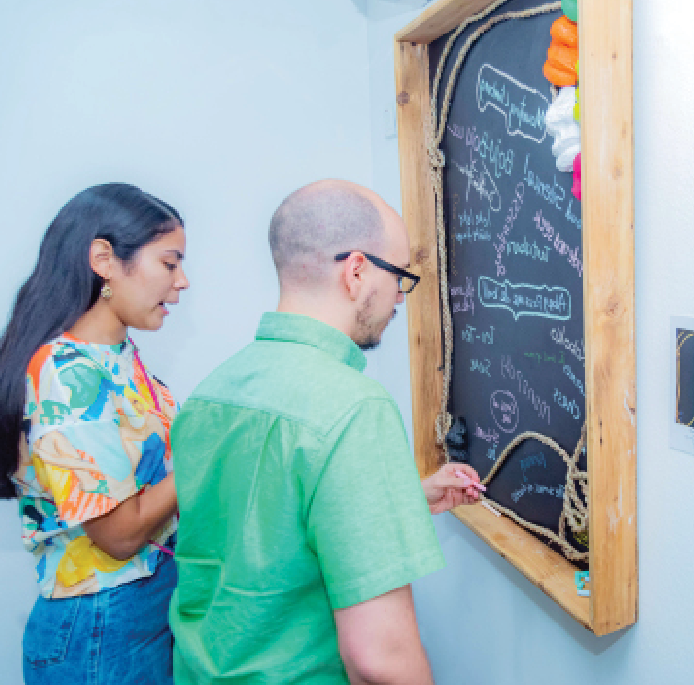Nzete’s The Year Of Knots Examines Impact Of Childhood Trauma And How It Shapes Us …C0NTINUE READING HERE >>>
In her third solo exhibition, The Year of Knots, artist, Helen Nzete explores childhood trauma and how it shapes us as adults, and in consequence addresses the issue of the rights of a child in the family and society.
A very personal exhibition, Nzete deploys knots as representations of the complex issues surrounding childhood experienced by many.
Comprised of 14 artworks, the exhibition begins with ‘Ties That Bond’, a mixed media piece sporting a wooden-framed, P.O.P sculpted face, rounded by entangled ropes. It speaks of the unique bonds of tension and support found within a family. The white rope is the security and safety that families should represent to their children, the flexible and sturdy ropes the strength and resilience that parents must embody for their children, and the loosened knots signifies the necessary space that parents must provide their children to enable them to grow, explore and experience life.
But what happens when parents refuse to loosen those knots? What happens when the family ceases to provide that support and security the child needs? Or when families become inflictors of traumas that children oftentimes carry long into adulthood?
Such was represented in the piece ‘Dubem’, about a seven-year-old boy whose father bathed his eyes with pepper as punishment for peeking at his older sister while dressing up. Then, dragged him school the next day with red eyes to further complete his humiliation by explaining his ‘crime’ to whoever asked.
The incident triggered a childhood memory in Nzete, who as a primary school pupil was disciplined by her mother before a neighbour, whose younger daughter framed her for the misuse of money meant for her textbooks to purchase ice-cream. Then made her go to school the next day.
‘Unseen’ resurrected memories Nzete shares with many middle-born children who are often overlooked in the family compared to the eldest child who can do no wrong or the baby of the house who has the affection of the parents. Combine that middle-born status with seemingly zero talent at childhood, or a learning disability, the child is bound to stick out like a sore thumb.
A self-diagnosed dyslexic, Nzete found it difficult to read and spell her name as a child. Like every parents of her generation who lacked awareness on learning disabilities, she was punished over the slightest mistakes.
“In the course of creating the pieces for this exhibition, I started to relive past events, that I couldn’t help but step away from the work. I’d be miserable for weeks. I would talk to a friend and feel better but that doesn’t mean I get back to the work immediately. That’s why the exhibition took two years to achieve.”
The Year of Knots is her way of exorcising her traumatic past, and highlighting issues around children and childhood that must be addressed in order to protect the rights of every child.
“My childhood was not completely bad. Rather there were emotional weights I had to carry. And now as a young adult and teenager, I got triggered by certain things or words people say. I wouldn’t want other children to experience that. It is the right of children to have a better tomorrow,” said Nzete.
Would she change her traumatic past if she could? The answer is an emphatic no. “If I do, today will not exist. This (exhibition) will not be, and I can’t trade this for anything. I’ve had time to think about it. My experiences push me to be who I am, and the way I understand life.”
Indeed, without her past, her life, her artistic growth and her friendships won’t exist.
Thus, in healing and helping others heal, the exhibition pieces as ‘Runaway’ helps her celebrate her friendship with her friend Raju, who has taught her to adopt ‘an attitude of gratitude’ whatever the situation or challenge she faces. ‘Fragments’ encourages viewers to celebrate the different facets of themselves. “We are all works in progress and can never really stop learning about ourselves every day.” The fragmented faces made of reflective Perspex and mirror indicates the different sides of us that different people experience at different occasions. To end the exhibition on a high note, ‘Sunshine and Vibes’ celebrates the friendships that completes us.”
While viewers tend to get lost in the themes and stories explored in the exhibition, the more impressive aspect of the exhibition is her medium which hugely expresses the themes she explores. It is typical Nzete. You will never catch her using same materials in any exhibition.
The sole things recurrent in her work are symbolisms, or her use of faces or faces with variant expressions (modeled after hers) and playful use of colours in this exhibition.
“I understand the need for personal style. I am not interested in a signature style, rather how best I can interpret the work at hand. I have a sculptural background. So, I have to build, if not, it’s not exciting for me. I usually think of a word that I can associate with the theme I have in mind, or a material I can use to execute it in a way the audience will understand.”
The result is the public’s emotional response and connection to the exhibition. “The reception has been overwhelming good. Everyone had good things to say,” said Nzete.
>
